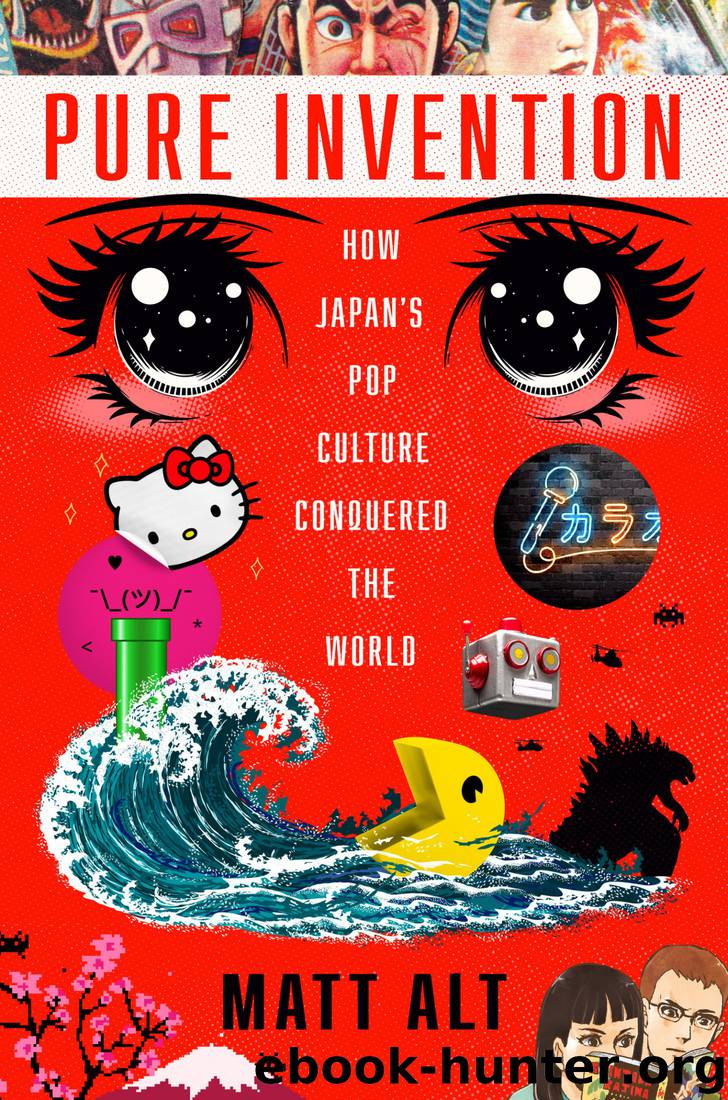Pure Invention: How Japan's Pop Culture Conquered the World by Matt Alt

Author:Matt Alt
Language: eng
Format: epub
Publisher: Crown
Published: 2020-06-22T23:00:00+00:00
* * *
—
THE YEAR 1995 was the roughest yet. In January, an earthquake leveled large parts of the city of Kobe. The government so thoroughly dithered its response, waiting more than seventy-two hours to dispatch Self-Defense Force rescue crews to help, that a local yakuza gang stepped in to distribute food and supplies to trapped citizens. Just a few months later, in March, an apocalyptic death cult called Aum Supreme Truth released handmade nerve gas in a crowded Tokyo subway station. The terrorist attack killed thirteen, grievously injured fifty, and sickened a thousand more. Taken together, the incidents raised disturbing questions about just who, if anyone, was really in charge anymore.
The backbone of Japan’s domestic and export consumer economy—high-tech manufacturers such as Hitachi, Toshiba, Mitsubishi, and NEC—were shedding catastrophic amounts of market share to Asian rivals. When President Bill Clinton made a trip to Asia in 1998, something happened that would have been unthinkable just a few years earlier: He skipped Tokyo. As American political and business leaders eagerly turned their gaze to newly ascendant China and South Korea, the same Japanese politicians who had railed against Japan bashing began fretting about what they called “Japan passing.”
Prolonged economic unease had a profound effect on young citizens, and the mass media eagerly chronicled a perceived crumbling of society. Terms like hikikomori (a coinage for young shut-ins who refuse to attend school or even leave their homes) and gakkyu hokai (“classroom chaos”) entered the popular lexicon. College grads, both male and female, desperately cast about for jobs in the midst of a hiring freeze so pronounced that it is now called shushoku hyogaki—the Ice Age of Employment. Many millions never launched careers at all. The kids, it seemed, weren’t all right.
It felt like everything had gone topsy-turvy, that a once-great nation was coming apart at the seams. Unable to attain the milestones of adulthood, Japan’s youth increasingly turned from mainstream culture to subcultures. Increasing numbers of young men and women immersed themselves in vibrant fantasy worlds, fashioning new identities for themselves as super-connoisseurs of manga, video games, and anime. The most striking changes, and the ones with the most global impact, played out in Tokyo’s fashion centers of Shibuya and Harajuku, where schoolgirls and young women fashioned new identities and forged new styles of communication. Among their tools were text-capable pocket pagers, mobile phones, and access to one of the world’s earliest mobile Internet providers. Grumpy grown-up critics framed these endeavors as a shirking of responsibility, an infantilization of a once-proud society, a great dropping out. But those in the thick of it knew they were plugging in to something new.
Interconnected like never before, sophisticated young consumers with an unceasing hunger to connect formed new social networks that transformed Japan’s city streets into petri dishes for cultural innovation. In an economy bloodied by the burst of the bubble, the nerds and the schoolgirls were the last consumers standing. Battle Royale may have been fiction, but maybe only by a little bit.
Download
This site does not store any files on its server. We only index and link to content provided by other sites. Please contact the content providers to delete copyright contents if any and email us, we'll remove relevant links or contents immediately.
| Accounting | Economics |
| Exports & Imports | Foreign Exchange |
| Global Marketing | Globalization |
| Islamic Banking & Finance |
The Meaning of the Library by unknow(2489)
Six Billion Shoppers by Porter Erisman(2255)
Why Nations Fail: The Origins of Power, Prosperity, and Poverty by Daron Acemoglu & James Robinson(2219)
No Time to Say Goodbye(2045)
Red Notice by Bill Browder(2014)
The Economist [T6, 22 Thg9 2017] by The Economist(1876)
Currency Trading For Dummies by Brian Dolan(1861)
Thank You for Being Late by Thomas L. Friedman(1721)
Bitcoin: The Ultimate Guide to the World of Bitcoin, Bitcoin Mining, Bitcoin Investing, Blockchain Technology, Cryptocurrency (2nd Edition) by Ikuya Takashima(1655)
Amazon FBA: Amazon FBA Blackbook: Everything You Need To Know to Start Your Amazon Business Empire (Amazon Empire, FBA Mastery) by John Fisher(1525)
Coffee: From Bean to Barista by Robert W. Thurston(1471)
The Future Is Asian by Parag Khanna(1424)
The Great Economists by Linda Yueh(1419)
How Money Got Free: Bitcoin and the Fight for the Future of Finance by Brian Patrick Eha(1375)
Grave New World by Stephen D. King(1370)
Pocket World in Figures 2018 by The Economist(1366)
Capitalism Without Capital: The Rise of the Intangible Economy by Jonathan Haskel(1365)
The Sex Business by Economist(1336)
Cultural Intelligence by David C. Thomas(1254)
